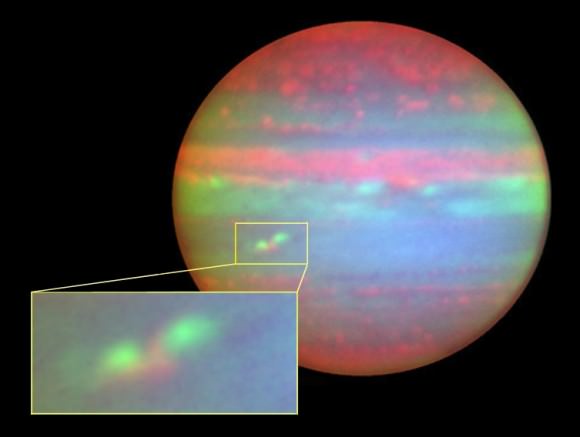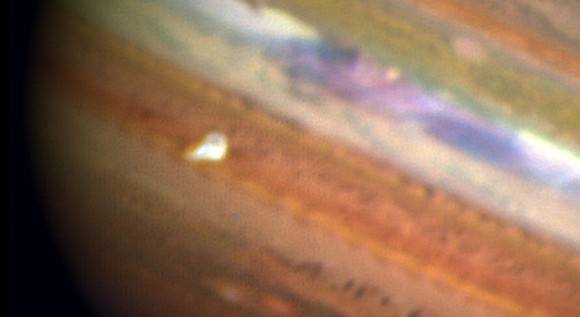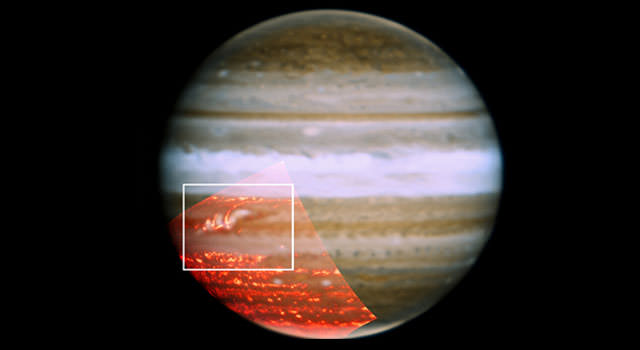[/caption]
Earlier this year, one of Jupiter’s stripes went missing. The Southern Equatorial Band started to get lighter and paler, and eventually disappeared. Now, follow-up images from both professional and amateur astronomers are showing some activity in the area of the SEB, and scientists now believe the vanished dark stripe is making a comeback. They say these new observations will help our understanding of the interaction between Jupiter’s winds and cloud chemistry.
“The reason Jupiter seemed to ‘lose’ this band – camouflaging itself among the surrounding white bands – is that the usual downwelling winds that are dry and keep the region clear of clouds died down,” said Glenn Orton, a research scientist at JPL. “One of the things we were looking for in the infrared was evidence that the darker material emerging to the west of the bright spot was actually the start of clearing in the cloud deck, and that is precisely what we saw.”

This white cloud deck is made up of white ammonia ice. When the white clouds float at a higher altitude, they obscure the missing brown material, which floats at a lower altitude. Every few decades or so, the South Equatorial Belt turns completely white for perhaps one to three years, an event that has puzzled scientists for decades. This extreme change in appearance has only been seen with the South Equatorial Belt, making it unique to Jupiter and the entire solar system.
The white band wasn’t the only change on the big, gaseous planet. At the same time, Jupiter’s Great Red Spot became a darker red color. Orton said the color of the spot – a giant storm on Jupiter that is three times the size of Earth and a century or more old – will likely brighten a bit again as the South Equatorial Belt makes its comeback.

The South Equatorial Belt underwent a slight brightening, known as a “fade,” just as NASA’s New Horizons spacecraft was flying by on its way to Pluto in 2007. Then there was a rapid “revival” of its usual dark color three to four months later. The last full fade and revival was a double-header event, starting with a fade in 1989, revival in 1990, then another fade and revival in 1993. Similar fades and revivals have been captured visually and photographically back to the early 20th century, and they are likely to be a long-term phenomenon in Jupiter’s atmosphere.
Scientists are particularly interested in observing this latest event because it’s the first time they’ve been able to use modern instruments to determine the details of the chemical and dynamical changes of this phenomenon. Observing this event carefully may help to refine the scientific questions to be posed by NASA’s Juno spacecraft, due to arrive at Jupiter in 2016, and a larger, proposed mission to orbit Jupiter and explore its satellite Europa after 2020.
Observations by amateur astronomers Christopher Go of Cebu City, Philippines and Anthony Wesley of Australia have helped, and scientists have used the “big guns” in Hawaii — NASA’s Infrared Telescope Facility, the W.M. Keck Observatory and the Gemini Observatory telescope.
Go imaged an outburst that piqued the interest of other astronomers. “I was fortunate to catch the outburst,” said Christopher Go, referring to the first signs that the band was coming back. “I had a meeting that evening and it went late. I caught the outburst just in time as it was rising. Had I imaged earlier, I would not have caught it,” he said.
Source: JPL


The pictures show a white equatorial band and a ‘normal’ looking equatorial band. The text says, that the pictures indicate signs of the returning of the currently white SEB to its usual look. But all the indications shown appear in the equatorial band that is NOT white. Can someone solve that riddle?
It says “false color” & “composites”. Depends on the photo orientation how to interpret; some photos are flipped back from observatory frame to show north as up, some not.